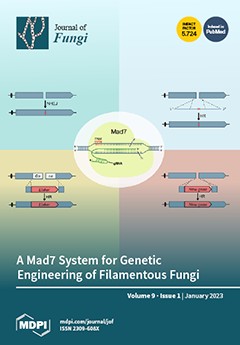Fungal species associated with crown and root rot diseases in wheat have been extensively studied in many parts of the world. However, no reports on the relative importance and distribution of pathogens associated with wheat crown and root rot in Kyrgyzstan have been published. Hence, fungal species associated with wheat crown/root rot were surveyed in three main wheat production regions in northern Kyrgyzstan. Fungal species were isolated on 1/5 strength potato-dextrose agar amended with streptomycin (0.1 g/L) and chloramphenicol (0.05 g/L). A total of 598 fungal isolates from symptomatic tissues were identified using morphological features of the cultures and conidia, as well as sequence analysis of the nuclear ribosomal internal transcribed spacer (ITS) region, the translation elongation factor 1α (
TEF1), and the RNA polymerase II beta subunit (
RPB2) genes. The percentage of fields from which each fungus was isolated and their relative percentage isolation levels were determined.
Bipolaris sorokiniana, the causal agent of common root rot, was the most prevalent pathogenic species isolated, being isolated from 86.67% of the fields surveyed at a frequency of isolation of 40.64%.
Fusarium spp. accounted for 53.01% of all isolates and consisted of 12 different species. The most common
Fusarium species identified was
Fusarium acuminatum, which was isolated from 70% of the sites surveyed with an isolation frequency of 21.57%, followed by
Fusarium culmorum,
Fusarium nygamai,
Fusarium oxysporum, and
Fusarium equiseti, all of which had a field incidence of more than 23%. Inoculation tests with 44 isolates representing 17 species on the susceptible
Triticum aestivum cv. Seri 82 revealed that
Fusarium pseudograminearum and
F. culmorum isolates were equally the most virulent pathogens. The widespread distribution of moderately virulent
B. sorokiniana appears to be a serious threat to wheat culture, limiting yield and quality. With the exception of
F. culmorum, the remaining
Fusarium species did not pose a significant threat to wheat production in the surveyed areas because common species, such as
F. acuminatum,
F. nygamai,
F. oxysporum, and
F. equiseti, were non-pathogenic but infrequent species, such as
Fusarium redolens,
Fusarium algeriense, and
F. pseudograminearum, were highly or moderately virulent.
Curvularia inaequalis, which was found in three different fields, was mildly virulent. The remaining
Fusarium species,
Fusarium solani,
Fusarium proliferatum,
Fusarium burgessii, and
Fusarium tricinctum, as well as
Microdochium bolleyi,
Microdochium nivale, and
Macrophomina phaseolina, were non-pathogenic and considered to be secondary colonizers. The implications of these findings are discussed.
Full article






